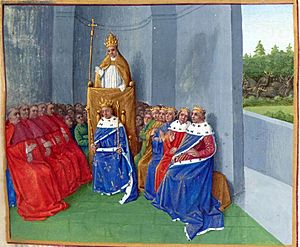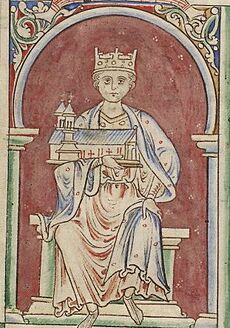Gerard (archbishop of York) facts for kids
Quick facts for kids |
|
|---|---|
| Archbishop of York | |
| Appointed | December 1100 |
| Reign ended | 21 May 1108 |
| Predecessor | Thomas of Bayeux |
| Successor | Thomas II of York |
| Orders | |
| Consecration | 8 June 1096 by Anselm |
| Personal details | |
| Died | 21 May 1108 Southwell |
| Buried | York Minster |
| Parents | Osbert and Anna |
| Previous post |
|
Gerard (died 21 May 1108) was an important figure in England. He served as Archbishop of York from 1100 to 1108. Before that, he was the Lord Chancellor of England from 1085 to 1092.
Gerard was from Normandy. He worked for the church in Rouen before joining the royal staff. He served under King William I of England and his son, King William II Rufus. King William I made him Lord Chancellor. He kept this job under King William II.
In 1096, King William II rewarded Gerard by making him Bishop of Hereford. Gerard might have been with King William II when the king died. This is because Gerard was a witness to the first official document signed by the new king, Henry I of England. This happened just days after William II's death.
Soon after Henry became king, Gerard was chosen to be the Archbishop of York. This led to a long-standing argument. The Archbishops of York and Canterbury often disagreed about who had more power in the English church. Gerard managed to get the Pope to agree that York had power over the church in Scotland. However, he had to make a deal with Anselm, the Archbishop of Canterbury. This deal gave Canterbury some authority over York, but it didn't apply to future archbishops.
Gerard also helped solve a big problem between the king and the Pope. This problem was called the Investiture Controversy. It was about who had the right to appoint bishops. Gerard worked to find a solution that both sides could accept. The problem was finally solved in 1107.
Gerard was a supporter of learning. He even encouraged some of his clergy to study Hebrew. This was unusual at the time. He also studied astrology, which led to some people calling him a magician. Because of these rumors and his attempts to change the rules for his church staff, Gerard was not buried inside York Minster at first. After his sudden death in 1108, his body was later moved into the cathedral.
Contents
Early Life and Royal Service
Gerard had important family connections. His uncle, Walkelin, was the Bishop of Winchester. Another uncle, Simon, was the Abbot of Ely. Gerard's parents were Osbert and Anna. His brother, Peter, also worked for the king.
We don't know exactly when or where Gerard was born. He worked at Rouen Cathedral as a church singer and leader of the choir. The exact dates for these roles are not known. By 1091, he became an archdeacon in Rouen. He served in the royal office that handled official documents for King William I and King William II.
Becoming a Bishop
Gerard became the Lord Chancellor of England in 1085. He was present when King William I died in 1087. He continued as Chancellor for King William II until 1092. It's not clear why he left this job.
However, King William II still trusted Gerard. In 1095, the king sent Gerard and William Warelwast on a special trip. They went to Pope Urban II to discuss Archbishop Anselm. The king wanted to recognize Urban as the true Pope, instead of another Pope called Clement III. In return, the king wanted Anselm removed from his position. He also wanted to control the pallium, a special cloth that shows an archbishop's authority.

Gerard's trip to Rome started in February 1095. He returned with a papal representative, Walter. Walter was a Cardinal Bishop. He brought Anselm's pallium. Walter made sure King William II recognized Urban as Pope. But Walter refused to remove Anselm from his position. King William II eventually accepted Anselm as archbishop. At the king's court in Windsor, he agreed that Anselm should receive the pallium.
Gerard was not yet a priest, but he was rewarded with the Bishopric of Hereford. Archbishop Anselm officially made him a bishop on 8 June 1096. Gerard had become a deacon and a priest the day before. He also helped with the official opening of St Paul's Cathedral in London on 9 June 1096.
Gerard might have been part of the hunting group in the New Forest on 2 August 1100. This was when King William II was killed. Gerard witnessed King Henry I's coronation document, known as the Charter of Liberties, three days later. This happened in Winchester, which is near the New Forest. Gerard was also at Henry's coronation that same day. He was with Maurice, Bishop of London. Maurice probably crowned Henry. However, some old writings suggest Gerard crowned Henry. This was supposedly in return for a promise of the first open archbishop position. Gerard might have helped Maurice in the ceremony.
Archbishop of York
Gerard became the Archbishop of York in December 1100. There is no record of the king formally appointing him. Archbishop Anselm encouraged Pope Paschal II to give Gerard his pallium. This suggests Gerard was not appointed by the king in a way that would cause problems.
In 1101, King Henry I, with Anselm's help, took away lands from Ranulf Flambard, the Bishop of Durham. This was because Ranulf had supported Henry's older brother, Robert Curthose. Robert also wanted to be king of England. Gerard then removed Ranulf from his bishopric.
Soon after moving to York, Gerard started a long disagreement with Anselm. Gerard claimed that the Archbishop of York had equal power to the Archbishop of Canterbury. He refused to promise to obey Anselm. This was part of the long Canterbury–York dispute. At a church meeting in Westminster in 1102, Gerard reportedly kicked over the smaller chair given to him. He refused to sit until he had a chair as large as Anselm's.
Gerard traveled to Rome in 1102 to get his pallium from the Pope. He also presented the king's side in the argument about who should appoint bishops. The Pope sided against the king. However, Gerard and two other bishops claimed the Pope had told them that rules against kings appointing bishops would not be strictly enforced. Anselm's representatives and the Pope denied this. The Pope then temporarily removed Gerard from the church until he took back his claim.
Gerard got the Pope to recognize York's power over the church in Scotland. He then made Roger the Bishop of Orkney. But he refused to make Thurgot the Archbishop of St Andrews in Scotland. This was because Thurgot would not accept York's authority.
Gerard gave many gifts to the monasteries in his area. An old writer named Hugh the Chantor said that Thomas II, Gerard's successor, accused Gerard of spending too much of the church's money. King Olaf I of Man and the Isles wrote to Gerard. He asked York to make "our bishop" official. But this doesn't seem to have happened under Gerard or his successor.
For the first four years of King Henry's rule, Gerard was one of his main advisers. Another key adviser was Robert of Meulan. Gerard was one of King Henry's strongest supporters among the bishops during the Investiture Crisis. In 1101, Gerard witnessed a treaty between Henry and Robert, the Count of Flanders. This treaty tried to keep Robert from getting involved in any future fights between Henry and his brother Robert Curthose.
After Gerard returned from Rome, he helped Ranulf Flambard get his bishopric of Durham back. In 1102, Anselm refused to make three bishops official. Two of them had been appointed by the king. Gerard offered to make them bishops instead. However, all but one refused.
From 1105 onwards, Gerard slowly started to agree with the Pope's view on appointing bishops. The Pope believed that regular people should not appoint bishops. As part of this change, Gerard spent more time focusing on his own church area. Towards the end of 1105, Gerard tried to join Bohemond of Antioch. Bohemond was gathering a group for a crusade in France. But King Henry seems to have stopped Gerard from leaving. In 1106, Gerard wrote to Bohemond that he was still planning to go on crusade, but he never did. Around the same time, Gerard worked to find a solution to the Investiture Crisis. He wrote letters and other works supporting Anselm's and the Pope's position. By 1107, King Henry and Anselm had reached an agreement to end the dispute.
Gerard agreed to a compromise about obeying Anselm. King Henry suggested that Anselm accept a promise from Gerard. Gerard would promise to follow the oath he made to Anselm when he became Bishop of Hereford. Gerard made this promise at a meeting in Westminster in 1107. This was a win for Canterbury, but not a complete one. Gerard avoided making a written promise. Also, the promise applied only to Gerard, not to future Archbishops of York. Gerard continued to disagree with Anselm's attempts to claim Canterbury's authority. But the two leaders became friends before Gerard died.
Gerard also had some difficulties with the church staff at his cathedral. He tried to reform them. He wanted them to give up their wives and partners and become ordained priests. In 1103, he wrote to Anselm complaining about how stubborn his staff were. He wished he had a better relationship with them. He complained that some of the York staff refused to become priests. This way, they hoped to avoid promising to remain single. He also said they took money but refused to live or work at the cathedral. They focused on a narrow legal definition of being single without actually being single. The staff argued they only had to avoid having women in their own homes. They said they were allowed to visit women in other houses. Gerard was not the only one who complained. The staff accused Gerard of making York poorer by giving away church lands to others.
Death and Legacy
Gerard was connected to the writers of two law books from the 12th century. An old writer named William of Malmesbury wrote about Gerard. He said Gerard was interested in studying Julius Firmicus Maternus, an old Roman astrologer. This led to some people thinking Gerard was a sorcerer.
On the positive side, Anselm thought Gerard was very learned and smart. Some poems written by Gerard still exist in old manuscripts. A collection of his letters was passed around in the mid-12th century. This collection was given to Bec Abbey in 1164. However, it is now lost.
Gerard died suddenly on 21 May 1108. He was in Southwell, on his way to London for a meeting. His body was found in an orchard. Next to him was a book of "curious arts," which was his copy of Julius Firmicus. His church staff refused to let him be buried inside his cathedral. Their dislike was probably more because Gerard tried to change their way of life. It was less about his supposed interest in sorcery. Gerard was first buried next to the porch at York Minster. But his successor, Thomas, later moved his body inside the cathedral.
Images for kids



